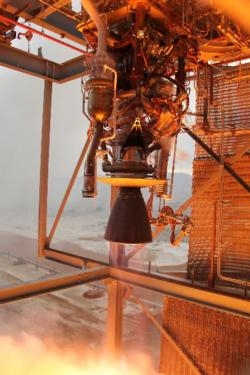Fri, Apr 17, 2015
Will Boost New Shepard Suborbital Flight
Blue Origin recently completed acceptance testing of its BE-3 rocket engine, the first new hydrogen engine to be developed in the United States in more than a decade. The 110,000-lbf BE-3 will power Blue Origin’s New Shepard suborbital system, and later, will be modified for upper stage applications.

"The BE-3 has now been fired for more than 30,000 seconds over the course of 450 tests,” said Jeff Bezos, Blue Origin founder. “We test, learn, refine and then test again to push our engines. The Blue Origin team did an outstanding job exploring the corners of what the BE-3 can do and soon we’ll put it to the ultimate test of flight.”
The BE-3 can be continuously throttled between 110,000-lbf and 20,000-lbf thrust, a key capability for vertical takeoff and vertical landing vehicles. The testing profile included multiple mission duty cycles, deep throttling and off-nominal test points.
“Liquid hydrogen is challenging, deep throttling is challenging and reusability is challenging," said Bezos. “This engine has all three. The rewards are highest performance, vertical landing even with a single-engine vehicle and low cost. And, as a future upper stage engine, hydrogen greatly increases payload capabilities.”
The BE-3 engine was designed and fabricated at Blue Origin’s design, development and production facility in Kent, Wash. Full-engine testing was conducted at the company’s facilities in West Texas, while earlier combustion chamber testing was completed at NASA’s Stennis Space Center in Mississippi.
The BE-3 is the third generation of Blue Origin-developed engines. The fourth-generation BE-4 uses liquid oxygen and liquefied natural gas (LNG) to produce 550,000-lbf thrust at sea level. Under development since 2012, the BE-4 provides the lowest cost and fastest production path to power the nation’s access to space. Selected by United Launch Alliance to serve as the primary propulsion provider for its Next Generation Launch System, Blue Origin is developing the BE-4 as an integrated part of America’s newest launch vehicle.
(Image provided by Blue Origin)
More News
He Attempted To Restart The Engine Three Times. On The Third Restart Attempt, He Noticed That Flames Were Coming Out From The Right Wing Near The Fuel Cap Analysis: The pilot repor>[...]
Make Sure You NEVER Miss A New Story From Aero-News Network Do you ever feel like you never see posts from a certain person or page on Facebook or Instagram? Here’s how you c>[...]
From 2009 (YouTube Edition): Leading Air Show Performers Give Their Best Advice for Newcomers On December 6th through December 9th, the Paris Las Vegas Hotel hosted over 1,500 air >[...]
Aero Linx: NASA ASRS ASRS captures confidential reports, analyzes the resulting aviation safety data, and disseminates vital information to the aviation community. The ASRS is an i>[...]
“For our inaugural Pylon Racing Seminar in Roswell, we were thrilled to certify 60 pilots across our six closed-course pylon race classes. Not only did this year’s PRS >[...]
 NTSB Final Report: Rutan Long-EZ
NTSB Final Report: Rutan Long-EZ ANN FAQ: Turn On Post Notifications
ANN FAQ: Turn On Post Notifications Classic Aero-TV: ICAS Perspectives - Advice for New Air Show Performers
Classic Aero-TV: ICAS Perspectives - Advice for New Air Show Performers ANN's Daily Aero-Linx (06.28.25)
ANN's Daily Aero-Linx (06.28.25) Aero-News: Quote of the Day (06.28.25)
Aero-News: Quote of the Day (06.28.25)



